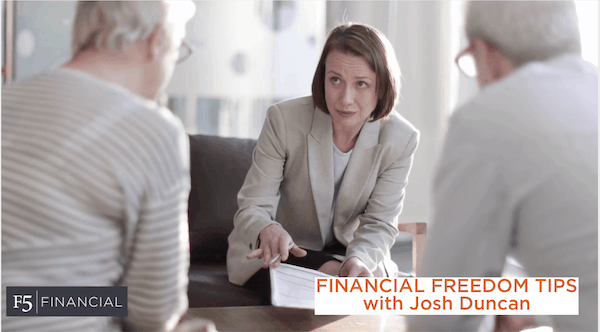
Financial Freedom Tips (Video) – Paying Debt with a 401(k) Loan
By: Josh Duncan
Looking to pay off large debt?
One option to consider is a 401(k) loan. In this 5-minute video, learn all the details about how these loans work—including specific benefits and risks.
We share which factors to weigh as you and your advisor evaluate the option of including a 401(k) loan in your plan for debt-free financial freedom.
All about 401(k) Loans
Full Transcript of video
Hello, I’m Josh Duncan with SCB News bringing you this edition of Financial Freedom. The purpose of Financial Freedom is to provide tips to help you achieve financial freedom for personal significance.
Western culture has many great aspects that make life fun and exciting. Just think about all the experiences we can enjoy with a flight, hotel, and rental car. Additionally, technology has changed our lives and made us more connected than ever. One side effect of our culture is our continuous striving for more. This can manifest in decisions that put our finances in the red by taking on excessive debt.
We are led to believe debt provides more freedom to have what we want today while paying for it over time. At least that’s what the mailers say that I receive weekly, urging me to take out a home equity line of credit to remodel my house. The reality is that this consumer debt puts us in bondage to the lender.
So, if you have arrived at the point where we agree and you want to clear up your debt, you may be looking for a way to do so quickly. Although the only quick fix to this situation is coming across a large enough sum of money to pay off the debt, there is another solution that may be helpful. I am referring to a loan from your 401(k) or 403(b) retirement plan. I am not suggesting this is the best way to pay off any or all your debt but suggesting it as option to research for your situation.
As you can imagine, there are rules and limits to these types of loans. Most plans will allow you to borrow 50% of your vested balance, up to $50,000. This means your retirement plan would have to be valued at $100,000 to borrow $50,000. Taking half of your nest egg to reduce debt could dramatically change your retirement plans. However, if you are making a behavioral change and not adding new debt, you may still be able to reach your goal with increased saving.
Now, these loans are not free. There is typically an origination fee, as many loans have. There may also be an annual maintenance fee. Be sure to compare the total fees to the amount you are borrowing to compare to other consumer loans you are considering.
Like most loans, you will also be paying interest on the loan. Typically, the interest rate will be the prime rate plus one or two percent. Now, the interest you are paying is actually paid to you within your plan. The only downside is you are repaying the loan with after-tax money and not getting the pre-tax advantage regular contributions have. This means you will pay tax on loan repayment portion of your money again when you begin withdrawing from the account in retirement. Since the interest rate will be lower than credit cards or other high-interest options, you need to be aware of how this works.
Even though you are paying yourself back the interest, there is an opportunity cost for removing this money from the market, which are the investments within your plan. If you are a growth investor, historical averages show you will probably earn less from the loan interest than from the market return.
Personal loans will have a five-year maximum repayment term. If you are borrowing for a new home purchase, your plan may allow a 15-year repayment term.
Finally, the loan payments are withheld from your paycheck, so no need to worry about making a payment. However, if you leave or lose your job, the loan may need to be repaid immediately. If the loan is not repaid, the remaining balance is considered a distribution and will be taxed as ordinary income. Additionally, if you are younger than 59 ½, there will be a 10% early withdrawal penalty. Be sure to factor this risk into your decision of taking this type of loan.
If you are considering solutions to paying off your debt, work with your financial professional to build your plan to financial freedom. There are many options available and one size does not fit all.
Thank you for joining me for Financial Freedom. I'm Josh Duncan, Financial Advisor with F5 Financial Planning, helping you achieve financial freedom for personal significance. Please contact me here to send topics you would like me to cover. See you next time.
Photo credit: SCB Video TV Marketing (producers of the video)
Most recent video blog post:
Financial Freedom Tips - Save Half Your Raise
F5 Financial
F5 Financial is a fee-only wealth management firm with a holistic approach to financial planning, personal goals, and behavioral change. Through our F5 Process, we provide insight and tailored strategies that inspire and equip our clients to enjoy a life of significance and financial freedom.
F5 Financial provides fee-only financial planning services to Naperville, Plainfield, Bolingbrook, Aurora, Oswego, Geneva, St. Charles, Wheaton, Glen Ellyn, Lisle, Chicago and the surrounding communities; to McDonough, Henry County, Fayette County, Atlanta and the surrounding communities; to Venice, Sarasota, Fort Myers, Port Charlotte, Cape Coral, Osprey, North Port, and the surrounding communities; and nationally.
We'd love to have the opportunity to hear about your situation. Contact us here to schedule an appointment for a consultation.
Learn more about What We Do.
Helping You With
Wealth Preservation – Wealth Enhancement – Wealth Transfer – Wealth Protection – Charitable Giving
